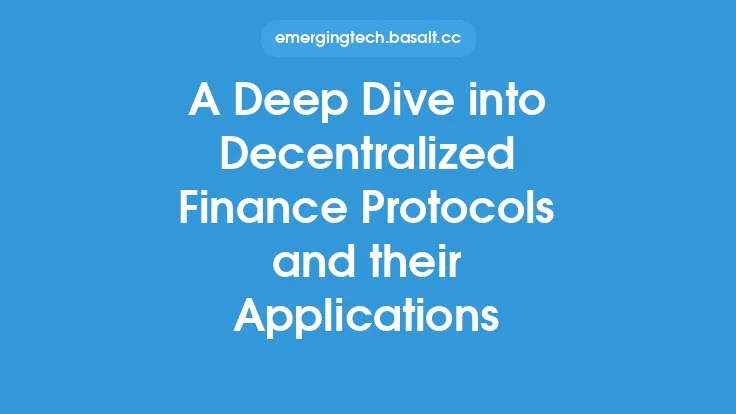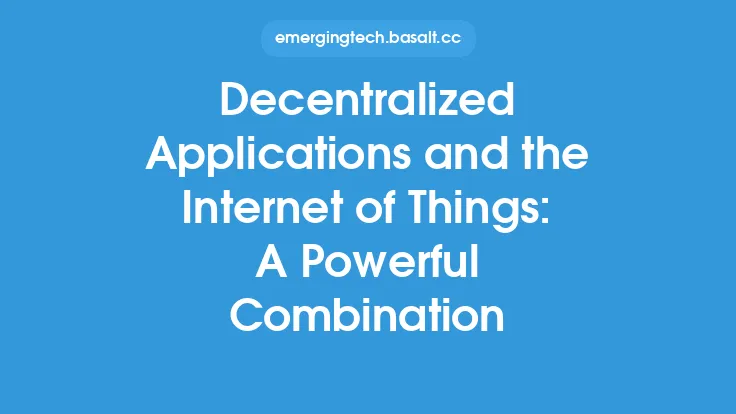The concept of decentralized applications, also known as dApps, has been gaining significant attention in recent years due to their potential to revolutionize the way we interact with digital systems. At their core, dApps are applications that run on a decentralized network, such as a blockchain, rather than a centralized server. This fundamental difference in architecture enables dApps to provide a more secure and transparent digital experience.
What are Decentralized Applications?
Decentralized applications are built on top of a blockchain network, which allows them to operate in a decentralized manner. This means that there is no single point of control or failure, as the application is maintained by a network of nodes rather than a single server. dApps can be built on various blockchain platforms, such as Ethereum, Polkadot, or Solana, each with its own set of features and capabilities. The decentralized nature of dApps enables them to provide a range of benefits, including increased security, transparency, and autonomy.
Key Characteristics of Decentralized Applications
Decentralized applications have several key characteristics that distinguish them from traditional centralized applications. Some of the most important characteristics of dApps include:
- Decentralized data storage: dApps store data on a decentralized network, such as a blockchain, rather than a centralized server. This provides a higher level of security and transparency, as data is maintained by a network of nodes rather than a single entity.
- Open-source code: dApps are typically built using open-source code, which allows developers to review, modify, and distribute the code freely. This promotes transparency, collaboration, and community involvement in the development process.
- Autonomous operation: dApps operate autonomously, without the need for a central authority or intermediary. This enables them to provide a more secure and transparent experience, as there is no single point of control or failure.
- Incentivization mechanisms: dApps often include incentivization mechanisms, such as token rewards, to encourage users to contribute to the network. This helps to promote engagement, participation, and decentralization.
Benefits of Decentralized Applications
Decentralized applications offer a range of benefits, including:
- Increased security: dApps are more secure than traditional centralized applications, as they are maintained by a network of nodes rather than a single server. This makes it more difficult for hackers to launch a successful attack, as they would need to compromise the entire network rather than a single point of failure.
- Improved transparency: dApps provide a higher level of transparency, as all transactions and data are recorded on a public ledger. This enables users to track the flow of data and assets, and ensures that the application operates in a fair and transparent manner.
- Enhanced autonomy: dApps operate autonomously, without the need for a central authority or intermediary. This enables them to provide a more secure and transparent experience, as there is no single point of control or failure.
- Increased community involvement: dApps often include incentivization mechanisms, such as token rewards, to encourage users to contribute to the network. This helps to promote engagement, participation, and decentralization.
Use Cases for Decentralized Applications
Decentralized applications have a wide range of potential use cases, including:
- Financial services: dApps can be used to provide financial services, such as lending, borrowing, and trading, in a more secure and transparent manner.
- Supply chain management: dApps can be used to track the movement of goods and assets, and provide a higher level of transparency and accountability.
- Social media: dApps can be used to create decentralized social media platforms, which provide a more secure and transparent experience for users.
- Gaming: dApps can be used to create decentralized gaming platforms, which provide a more secure and transparent experience for players.
Challenges and Limitations of Decentralized Applications
While decentralized applications offer a range of benefits, they also face several challenges and limitations, including:
- Scalability: dApps can be slower and more expensive to use than traditional centralized applications, due to the need to process transactions on a decentralized network.
- Regulation: dApps are often unregulated, which can make it difficult for users to understand their rights and obligations.
- User experience: dApps can be more complex and difficult to use than traditional centralized applications, due to the need to interact with a decentralized network.
- Security: while dApps are more secure than traditional centralized applications, they are not immune to security risks and vulnerabilities.
Conclusion
Decentralized applications have the potential to revolutionize the way we interact with digital systems, by providing a more secure and transparent experience. While they face several challenges and limitations, the benefits of dApps make them an exciting and promising area of development. As the technology continues to evolve and mature, we can expect to see a wide range of innovative use cases and applications emerge, which will help to shape the future of the digital world.





